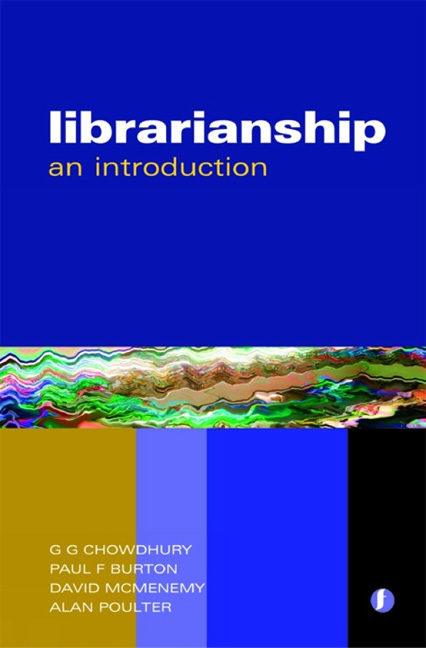Book contents
- Frontmatter
- Contents
- Preface
- Acknowledgements
- 1 Introduction
- Part 1 Libraries and information services: evolution or revolution?
- Part 2 Library and information resources and services
- Part 3 Information organization and access
- Part 4 Library and information users and society
- Part 5 Library technologies
- 17 Fundamentals of computing and the information age
- 18 Information technology standards: databases, markup and the internet
- 19 Library management systems
- 20 Digital libraries
- Part 6 Management and marketing in libraries
- Part 7 Education and research in librarianship
- Epilogue
- Glossary
- Resource list
- Index
20 - Digital libraries
from Part 5 - Library technologies
Published online by Cambridge University Press: 08 June 2018
- Frontmatter
- Contents
- Preface
- Acknowledgements
- 1 Introduction
- Part 1 Libraries and information services: evolution or revolution?
- Part 2 Library and information resources and services
- Part 3 Information organization and access
- Part 4 Library and information users and society
- Part 5 Library technologies
- 17 Fundamentals of computing and the information age
- 18 Information technology standards: databases, markup and the internet
- 19 Library management systems
- 20 Digital libraries
- Part 6 Management and marketing in libraries
- Part 7 Education and research in librarianship
- Epilogue
- Glossary
- Resource list
- Index
Summary
Introduction
Digital libraries embody the effects ICT changes have had on the form and function of libraries. Collections, services, users and the nature of library work are all challenged by this concept, which itself is somewhat fluid and difficult to pin down.
What is a digital library?
The term ‘digital library’ is one which is used both commonly and conspicuously but also incorrectly. Its commonly assumed definition is a library in which the collections and services of a ‘standard’ library have been translated into purely digital form. The problem with this is that there are probably only a tiny number of libraries that fit this definition. The vast majority of libraries in the information age still have significant ‘non-digital’ collections and still have a physical base in which the majority of their services, performed by librarians, are organized and delivered. The correct term for these is the ‘hybrid library’, one that provides a mixture of digital and non-digital resources and services. Most libraries today are in this position. However, since common usage has settled on digital library, that is the term which will be used to encapsulate the current form and role of libraries in the information age (Deagan and Tanner, 2002; Fox and Urs, 2002; Tedd and Large, 2005). The term ‘virtual library’ is also used (see Chapter 14) and refers to a library accessed in a non-physical manner.
Digital libraries are of interest to those outside the library profession: computer scientists research them, for example, looking at the technical issues in their operation (Arms, 2000). In recent decades governments have invested in research in digital libraries, to help realize their promise. As a result there are many projects to consider as possible sources of ideas for digital library developments. One such project outcome, Greenstone (www.greenstone.org), is a free open-source toolkit for developing digital libraries.
Digital libraries can be characterized by having:
• collections of items in a digital form
• an internet-based service location
• users who may be various and dispersed but are nevertheless interested in the Collections
• staff taking a less up-front role in service delivery, by replacing direct interaction with users with digital services development and interface design.
Information
- Type
- Chapter
- Information
- LibrarianshipAn introduction, pp. 215 - 228Publisher: FacetPrint publication year: 2007
